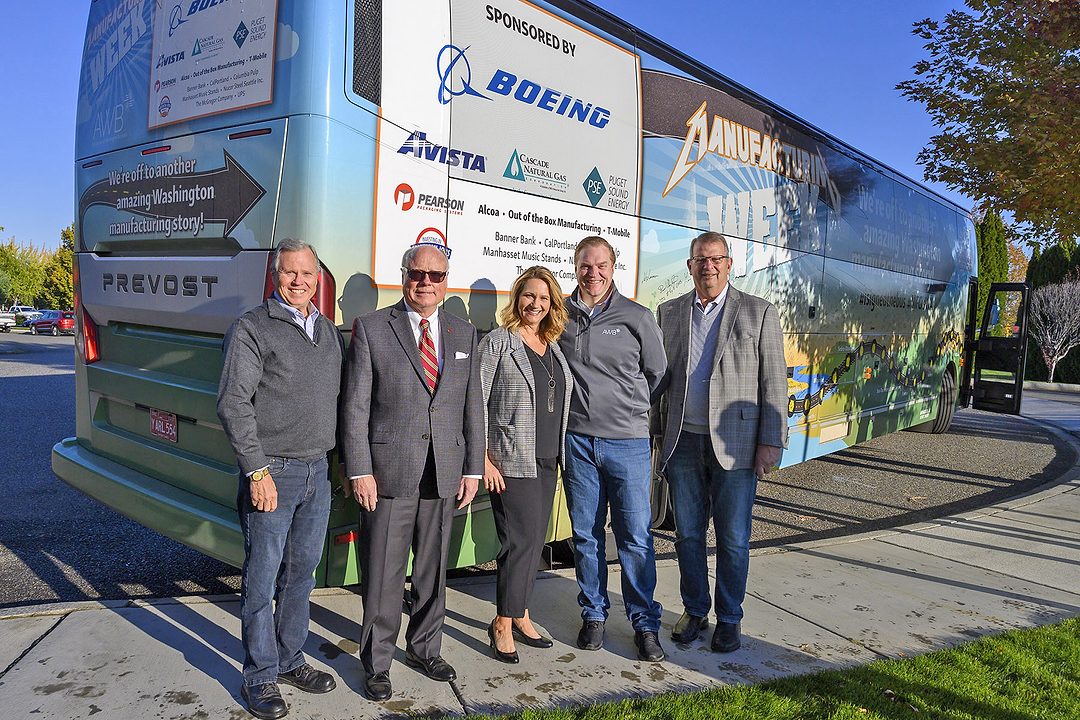
Home » It’s time to celebrate the amazing things Washington makes
It’s time to celebrate the amazing things Washington makes

October 10, 2019
By Kris Johnson
Washington makes some really cool things.
We’re famous for many of them—airplanes, apples, software, wheat and more. The state’s iconic manufacturers established the foundation that our recent economic expansion is built upon.
But there are many medium and small manufacturers that fewer people know about. The fishing rod manufacturer in Woodland. The music stand manufacturer in Yakima. The boat builder in Colville. And the manufacturing company in Richland that makes surgical tools to help heal patients around the world.

This year, for the third straight October, the Association of Washington Business hit the road in a big, custom-wrapped bus to travel the state in support of manufacturers—big and small, global icons, virtual unknowns and everything in between.
The tour stopped in the Tri-Cities on Oct. 10, visiting Cascade Natural Gas in Kennewick, United Western Technologies in Pasco and Plastic Injection Molding in Richland.
Over the course of seven days, we stopped at small, medium and large manufacturing companies in every corner of Washington to raise awareness about the importance of manufacturing to the state’s economy and to shine a light on some of the amazing things Washington makes.
Here in Washington, manufacturing accounts for nearly 12 percent of the total output in the state and employs nearly 8.5 percent of the workforce. Because it’s such a critical part of the economy, we use the tour to talk with manufacturers about what’s keeping them up at night and look for ways to support them.
We know some of the major issues already: educating the next generation workforce, supporting trade and exports, and supporting tax and regulatory policies that protect the ability of manufacturers to compete in a global economy.
One of the most consistent and urgent issues we hear from the manufacturers we visit is the shortage of an educated, skilled and trained workforce.
There are currently 12.8 million manufacturing jobs in the country, according to the National Association of Manufacturers. Over the next decade, the NAM predicts 4.6 million manufacturing jobs will likely be needed and 2.4 million are expected to go unfilled due to the skills gap.
National Manufacturing Day, which is always the first Friday in October, is part of the effort to address this critical issue. Manufacturers around the country open their doors and invite young people to come inside and learn about the career potential in manufacturing.
This is not your grandfather’s manufacturing economy. In many respects, today’s manufacturing jobs are high-tech jobs. In Washington, the average manufacturing worker makes over $88,000, well above the statewide average of $58,000.
For decades, manufacturing has provided a path to the middle class, a way out of poverty and a path of opportunity. Today’s young people—and their parents—need to know it still does.
Trade and export policy also is an important issue for Washington manufacturers. Washington is the most trade-driven state in the nation per capita, and the goods we make here get sent throughout the world. Last year, Washington exported more than $63 billion worth of manufactured goods and manufacturing accounted for more than 80 percent of the state’s total exports.
This is why programs like the Export-Import Bank, which provides credit to overseas purchasers of U.S. goods and services, and the United States-Mexico-Canada Agreement, which modernizes the North American Free Trade Agreement, are so important.
For manufacturers to succeed, they need to have access to global markets. They need educated, trained and skilled employees. They need predictable and competitive tax and regulatory policies.
And it doesn’t hurt, every now and then, to stop and celebrate the cool things they make.
Kris Johnson is president of the Association of Washington Business, the state’s chamber of commerce and manufacturers association.
Local News
KEYWORDS october 2019





